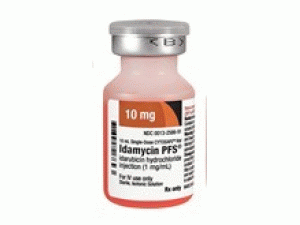盐酸伊达比星注射液(Idamycin for Intravenous Use)
 产地国家:日本
处方药:是
所属类别:1毫克/毫升 20毫升/瓶
包装规格:1毫克/毫升 20毫升/瓶
计价单位:瓶
生产厂家英文名:Pfizer Inc.
原产地英文商品名:Idamycin(イダマイシン静注用)5mg/vial 5vial/box
原产地英文药品名:Idarubicin Hydrochloride
中文参考商品译名:Idamycin(イダマイシン静注用)5毫克/瓶 5瓶/盒
中文参考药品译名:盐酸伊达比星
曾用名:去甲氧基柔红霉素
产地国家:日本
处方药:是
所属类别:1毫克/毫升 20毫升/瓶
包装规格:1毫克/毫升 20毫升/瓶
计价单位:瓶
生产厂家英文名:Pfizer Inc.
原产地英文商品名:Idamycin(イダマイシン静注用)5mg/vial 5vial/box
原产地英文药品名:Idarubicin Hydrochloride
中文参考商品译名:Idamycin(イダマイシン静注用)5毫克/瓶 5瓶/盒
中文参考药品译名:盐酸伊达比星
曾用名:去甲氧基柔红霉素
简介:
部份中文伊达比星处方资料(仅供参考)药品英文名Idarubicin药品别名善佳达、脱甲氧柔红霉素、埃得霉素、去甲氧基柔红霉素、4-去甲氧基柔红霉素、善唯达、Idamycin、Zavedos、Demethoxydaunorubicin药物剂型注射剂(粉):5mg,10mg,20mg。药理作用IDA为Arcamone等于1976年合成的DNR衍生物。本品与DNA结合,对核酸多聚酶具有显著抑制作用,对RNA合成以及纤维母细胞增殖的抑制作用比DNR强。动物实验表明,其心脏毒性指数比DNR和ADM低。类似多柔比星。其抗癌作用较多柔比星或柔红霉素强。 药动学:静脉给药后迅速分布并与体内各种组织结合,分布容积可能超过2000L/kg,肝内肝外广泛代谢。IDA的血浆清除为三相,终末半衰期23h。主要代谢物伊达比星醇(13-二氢伊达比星)具有相等的抗癌活性。进入骨髓中和有核血细胞中的本品及其代谢物的峰值分别高于血浆中的400倍和200倍。细胞中的药物和代谢物的终末t1/2分布为15h和72h,而两者在血浆中的t1/2分别为20~22h和45h。本品主要经胆汁排出,少量以原药和代谢物随尿排出。本品口服可吸收,生物利用度为20%~50%。能透过血-脑脊液屏障。 适应症:主要用于成人非淋巴细胞白血病(ANLL)诱导缓解的一线药物或用于复发、难治患者的诱导缓解以及成人和儿童急性淋巴细胞白血病的二线治疗。对霍奇金病和缓慢进展型非霍奇金淋巴瘤也有效,也可用于晚期乳腺癌的治疗。 禁忌症:纵隔、心包区有过放疗或用过潜在性心脏毒性药物以及患者伴有其他疾病(如贫血、骨髓抑制、感染、心肌炎)时,IDA的心脏毒性增大,对本品过敏者、哺乳者应禁用。 注意事项:1.肝肾功能不全者慎用。2.用药期中,应定期检查血象、肝肾功能和心电图,严密监护心毒性。3.肝肾功能不全者应减量。4.第1疗程中如已出现严重的黏膜炎,用量应至少减少25%。5.如出现严重的骨髓抑制或心脏毒性反应,应即时停药。6.本品不可皮下注射或肌内注射。7.当配置的溶液溢出或漏出皮肤外时,应用清水冲洗。8.本药与碱性液接触会降解,与肝素合用会产生沉淀,故不要与其他药物混合。9.静脉注射外渗会引起严重的局部组织坏死。 不良反应:1.主要为骨髓抑制和心脏毒性。在实体瘤,白细胞减少比血小板减少更常见。静脉注射IDA10~12.5mg/m2与静脉注射ADM60mg/m2和口服IDA40~45mg/m2的骨髓抑制作用相等。治疗过程中或停止治疗后几周内,可能发生的心脏毒性反应为充血性心力衰竭、急性心律失常及心肌病,出现这些反应时可采用洋地黄、利尿剂、限制钠盐及卧床休息等措施。在推荐剂量的基础上,静脉用药两个疗程后的累积剂量可达到60~80mg/m2。虽然没有最高累积剂量,但避免发生心脏毒性的平均累积剂量为93mg/m2。2.恶心、呕吐、食管炎、腹泻、黏膜炎(尤其是口腔黏膜炎)出现于治疗后3~10天。3.可逆性脱发,但胃肠道反应和脱发的发生率较ADM或DNR轻。4.发热、皮疹。5.20%~30%患者肝脏酶类和胆红素增高,具有可逆性。6.肾毒性及神经毒性。胆红素、AST及尿素氮水平在白血病后期强化治疗时,IDA组较DNR组为高。另外,使用本药1~2天后尿呈红色。 用法用量:1.本品不可做皮下或肌内注射。2.英国用注射用水配制药液,美国则用0.9%氯化钠注射剂。其快速输注方法可参照柔红霉素的有关叙述。3.治疗成人急性非淋巴细胞白血病每天可用12mg/m2,连用3天,并可联合使用阿糖胞苷。作为单药使用的以上方案也可治疗急性淋巴细胞白血病。另一替代方案是每天8mg/m22,连用5天。4.儿童急性淋巴细胞白血病每天可用10mg,连用3天。5.当不能打开静脉通路时,可单用本品口服,成人急性非淋巴细胞白血病每天可服30?mg/m2,连用3天;或每天15~30mg/m2,并配合其他抗癌药。6.晚期难治性乳腺癌可单用本品口服,45mg/m2,1次服或分为3次连服3天。根据血象恢复情况,3~4周后可以重复。 药物相应作用:应限制钠盐的摄入,避免与pH值在7以上的注射剂配伍(以免混浊)。专家点评国外报道,对复发或难治的急性骨髓细胞白血病,应用本品联合阿糖胞苷静脉注射,结果完全缓解率为24%~70%,但缓解时间短,仅1例完全缓解时间达14个月以上。对急性骨髓细胞白血病进行诱导治疗,联合应用阿糖胞苷静脉注射的疗效与柔红霉素联合阿糖胞苷治疗的效果相同。另一报道,应用本品联合氟尿嘧啶、环磷酰胺(IFC)方案治疗42例晚期乳腺癌患者,结果完全缓解者5例,部分缓解者8例,平均缓解期为8个月。 在美国进行的3次临床研究中,对2次未经治疗的急性骨髓细胞白血病者,应用口服本品联合阿糖胞苷治疗,其生存时间比柔红霉素联合阿糖胞苷治疗的长,用药后18个月的生存率前者为48%和35%;后者为28%和23%。本品联合阿糖胞苷静脉注射对成人急性非淋巴细胞白血病者也有效,反复用药后患者的完全缓解率为56%~77%,单独应用治疗乳腺癌也显示了良好的疗效。 IDA是治疗急性白血病的有效药物,特别是在急性粒细胞白血病治疗中,IDA与Ara-C联合用药比标准的DNR加Ara-C方案CR率高。本品具有疗效高、心脏毒性低,且可口服等优点。静脉用药过程中,应注意勿漏出血管外。单用IDA治疗难治或复发性ANLL的CR率为13%~32%,与Ara-C合用,CR率为24%~70%,而对初诊患者,联合用药的CR率可达80%~83%,且大多数病例在用一个周期后即缓解。 对难治或复发性ALL,IDA单一给药CR率低,成人为30%~33%,儿童为25%~40%;与Ara-C合用,儿童和成人CR率分别为63%~69%和50%~54%,其中用中剂量Ara-C效果较好。IDA与其他对ALL有效的药物联合应用,在初治的儿童和成人病例中可取得62%~82%和45%~50%的CR率。 口服IDA对晚期乳腺癌的有效率为29%(33/114)。对于慢性粒细胞白血病加速期或急变期,采用IDA单药或与Ara-C联合化疗,可以降低白细胞数或恢复慢性期。Bermen等采用IDA加Ara-C治疗10例急变期患者,4例恢复慢性期,其中2例治疗前Ph染色体阳性,治疗后转阴。Hollingsheed等总结了9个单位的处于加速或急变期的67例患者,只有1例CR。因此,IDA治疗CML加速或急变期仅是一种姑息手段,CR者极少。英文版说明书:
Generic Name: idarubicin hydrochlorideDosage Form: InjectionFOR INTRAVENOUS USE ONLYWarningsIdamycin PFS Injection should be given slowly into a freely flowing intravenous infusion. It must never be given intramuscularly or subcutaneously. Severe local tissue necrosis can occur if there is extravasation during administration.As is the case with other anthracyclines the use of Idamycin PFS can cause myocardial toxicity leading to congestive heart failure.Cardiac toxicity is more common in patients who have received prior anthracyclines or who have pre-existing cardiac disease.As is usual with antileukemic agents, severe myelosuppression occurs when Idamycin PFS is used at effective therapeutic doses.It is recommended that Idamycin PFS be administered only under the supervision of a physician who is experienced in leukemia chemotherapy and in facilities with laboratory and supportive resources adequate to monitor drug tolerance and protect and maintain a patient compromised by drug toxicity. The physician and institution must be capable of responding rapidly and completely to severe hemorrhagic conditions and/or overwhelming infection.Dosage should be reduced in patients with impaired hepatic or renal function. (See DOSAGE AND ADMINISTRATION.)Idamycin PFS - Clinical PharmacologyMechanism of ActionIdarubicin hydrochloride is a DNA-intercalating analog of daunorubicin which has an inhibitory effect on nucleic acid synthesis and interacts with the enzyme topoisomerase II.The absence of a methoxy group at position 4 of the anthracycline structure gives the compound a high lipophilicity which results in an increased rate of cellular uptake compared with other anthracyclines.PharmacokineticsGeneral Pharmacokinetics Pharmacokinetic studies have been performed in adult leukemia patients with normal renal and hepatic function following intravenous administration of 10 to 12 mg/m2 of idarubicin daily for 3 to 4 days as a single agent or combined with cytarabine. The plasma concentrations of idarubicin are best described by a two or three compartment open model. The elimination rate of idarubicin from plasma is slow with an estimated mean terminal half-life of 22 hours (range, 4 to 48 hours) when used as a single agent and 20 hours (range, 7 to 38 hours) when used in combination with cytarabine. The elimination of the primary active metabolite, idarubicinol, is considerably slower than that of the parent drug with an estimated mean terminal half-life that exceeds 45 hours; hence, its plasma levels are sustained for a period greater than 8 days.DistributionThe disposition profile shows a rapid distributive phase with a very high volume of distribution presumably reflecting extensive tissue binding.Studies of cellular (nucleated blood and bone marrow cells) drug concentrations in leukemia patients have shown that peak cellular idarubicin concentrations are reached a few minutes after injection.Concentrations of idarubicin and idarubicinol in nucleated blood and bone marrow cells are more than a hundred times the plasma concentrations.Idarubicin disappearance rates in plasma and cells were comparable with a terminal half-life of about 15 hours. The terminal half-life of idarubicinol in cells was about 72 hours. The extent of drug and metabolite accumulation predicted in leukemia patients for Days 2 and 3 of dosing, based on the mean plasma levels and half-life obtained after the first dose, is 1.7- and 2.3-fold, respectively, and suggests no change in kinetics following a daily × 3 regimen. The percentages of idarubicin and idarubicinol bound to human plasma proteins averaged 97% and 94%, respectively, at concentrations similar to maximum plasma levels obtained in the pharmacokinetic studies.The binding is concentration independent. The plasma clearance is twice the expected hepatic plasma flow indicating extensive extrahepatic metabolism.MetabolismThe primary active metabolite formed is idarubicinol. As idarubicinol has cytotoxic activity, it presumably contributes to the effects of idarubicin.EliminationThe drug is eliminated predominately by biliary and to a lesser extent by renal excretion, mostly in the form of idarubicinol.Pharmacokinetics in Special PopulationsPediatric PatientsIdarubicin studies in pediatric leukemia patients, at doses of 4.2 to 13.3 mg/m2/day × 3, suggest dose independent kinetics.There is no difference between the half-lives of the drug following daily × 3 or weekly × 3 administration. Cerebrospinal fluid (CSF) levels of idarubicin and idarubicinol were measured in pediatric leukemia patients treated intravenously. Idarubicin was detected in 2 of 21CSF samples (0.14 and 1.57 ng/mL), while idarubicinol was detected in 20 of these 21 CSF samples obtained 18 to 30 hours after dosing(mean = 0.51 ng/mL; range, 0.22 to 1.05 ng/mL). The clinical relevance of these findings is unknown.Hepatic and Renal ImpairmentThe pharmacokinetics of idarubicin have not been eva luated in leukemia patients with hepatic impairment.It is expected that in patients with moderate or severe hepatic dysfunction, the metabolism of idarubicin may be impaired and lead to higher systemic drug levels.The disposition of idarubicin may be also affected by renal impairment. Therefore, a dose reduction should be considered in patients with hepatic and/or renal impairment (see DOSAGE AND ADMINISTRATION)。用药温馨提示:当您服用此药物时,需定期接受医疗专业人士的检查,以便随时针对其药效、副作用等情况进行监测。本网站所包含的信息旨在为患者提供帮助,不能代替医学建议和治疗。
药品价格查询,专业药品查询网站,药品说明书查询,药品比价 » 盐酸伊达比星注射液(Idamycin for Intravenous Use)
药品价格查询,专业药品查询网站,药品说明书查询,药品比价 » 盐酸伊达比星注射液(Idamycin for Intravenous Use)


